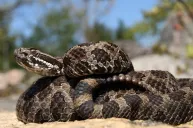Here's how to identify this common turtle species and how it survives in the wild.
One of the more colorful reptiles to be frequently found in the Midwest, the Terrapene carolina carolina is a subspecies of the common box turtle.
It sports a distinctive dome-shaped carapace that covers most of its body with a hinged plastron for full shell closure. Coloration can vary but is usually dark brown or black with brilliant yellow or orange blotches. Males often have blue patches on the head and legs as well as red eyes, while females usually have brown eyes. Eastern box turtles average 4.5-6 inches in length.
Home Range & Habitat
These common turtles are primarily found in the eastern United States including Maine, New York, Tennessee, and Florida as well as the Great Lakes region of Michigan and Ohio. They prefer warm weather but will find protection from the sun under foliage or water in extreme heat. Eastern box turtles can live in a variety of habitats, including moist forest floors and open grasslands. Most people tend to see them when they are crossing the road or a grassy trail.
Behavior & Diet

Getty Images: stanley45
They're an omnivorous species, but young box turtles usually eat more meat than their older counterparts. Their diets usually include snails, earthworms, amphibians, insects, and berries. Basically, a little bit of everything.
These diurnal turtles hibernate in certain regions by burrowing deep into stumps or water bottoms. When adult box turtles feel threatened, they can completely retract into their shells for protection. This can cause frustrated predators to give up and leave, saving the turtle's life.
Life Span
Like many reptiles, this turtle is known for living an extraordinarily long time. Eastern box turtles typically mate between April and October with one clutch of two to eight eggs per year. Nests are located under the soil, and incubation takes about three months. If the nest temperature is warm, hatchlings will usually be female. Cool nests typically yield male hatchlings. They reach sexual maturity between 10 and 20 years of age but have been known to have lifespans exceeding 100 years!
Unfortunately, some states have been forced to list the eastern box turtles as a species of special concern. This is mostly because this turtle species is at risk due to loss of habitat, pet trade, vehicular accidents, and predation.
NEXT: BLACK BEAR LIFESPAN IN NORTH AMERICA
WATCH




